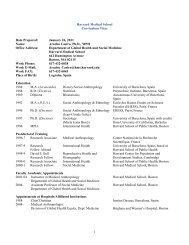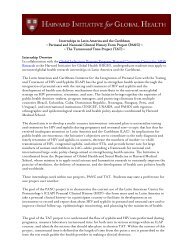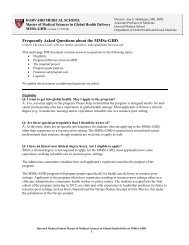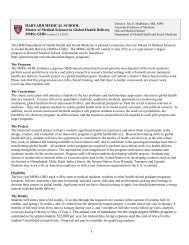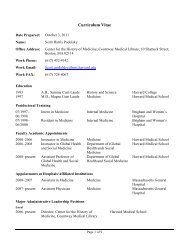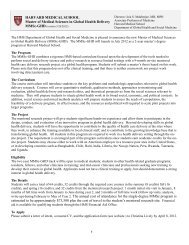Haiti Case Study - The Department of Global Health and Social ...
Haiti Case Study - The Department of Global Health and Social ...
Haiti Case Study - The Department of Global Health and Social ...
You also want an ePaper? Increase the reach of your titles
YUMPU automatically turns print PDFs into web optimized ePapers that Google loves.
COORDINATION MECHANISMS FOR THE SECURITY COMMUNITY<br />
What were coordination mechanisms, both formal <strong>and</strong> informal, that facilitated or directed the security<br />
community’s involvement?<br />
64. Because the scope <strong>and</strong> scale <strong>of</strong> the disaster was so large, no single multinational<br />
organization or nation could respond adequately alone. Rather, the response inspired some<br />
nations to marshal new whole <strong>of</strong> government responses, <strong>and</strong> most organizations on the<br />
ground in <strong>Haiti</strong> had to create new coordination mechanisms to align the plethora <strong>of</strong><br />
stakeholders <strong>and</strong> responders across the global response community. Having to create these<br />
new coordination structures likely impaired the efficiency <strong>of</strong> the response—a factor that may<br />
have driven up mortality as patients succumbed to earthquake-derived injuries. 58<br />
65. It proved to be an enormously complex undertaking to create the coordination<br />
mechanisms to direct relief, recovery <strong>and</strong> reconstruction efforts among the <strong>Haiti</strong>an<br />
government, MINUSTAH <strong>and</strong> associated UN agencies, bilateral responders like the US,<br />
Canada <strong>and</strong> France, <strong>and</strong> other donor governments, military forces <strong>and</strong> relief agencies.<br />
Creating these coordination mechanisms was driven by changing needs on the ground,<br />
changing groups <strong>of</strong> stakeholders over time, <strong>and</strong> the learning curves <strong>of</strong> stakeholders with<br />
respect to how best to work within their own organization <strong>and</strong> with one another. Personal<br />
relationships <strong>and</strong> necessity drove much <strong>of</strong> this process, especially in the early phase.<br />
66. Each stakeholder, including the <strong>Haiti</strong>an government, needed to organize itself internally<br />
such that it could interface with this core coordination structure. As one participant<br />
described, “I had to laugh at all the various flow charts that flew across my desk in the early<br />
days [after the earthquake]. <strong>The</strong>y were all trying to backtrack <strong>and</strong> trace the relationships <strong>and</strong><br />
processes that were already happening.” 59<br />
67. Early on, the <strong>Haiti</strong>an government stood up the Council <strong>of</strong> Ministers, which met daily at<br />
a small police station next to the destroyed airport to plan the response strategy. On 15<br />
January, they created six sector based working groups to interface with the international<br />
response community. However missing staff, lack <strong>of</strong> assets including communications <strong>and</strong><br />
information gathering tools, lack <strong>of</strong> experience in managing a disaster <strong>of</strong> this scope, as well<br />
as the sheer size <strong>of</strong> the disaster <strong>and</strong> the subsequent response, all contributed to hindering<br />
the government’s effectiveness.<br />
68. <strong>The</strong> <strong>Haiti</strong>an government <strong>and</strong> MINUSTAH, with the support <strong>of</strong> the US government <strong>and</strong><br />
other responding nations, forged an improved coordination structure that rolled out on 22<br />
January, ten days after the earthquake. 60 At the strategic level, the High Level Coordination<br />
Committee (HLCC) oversaw the response <strong>and</strong> reconstruction. It was chaired by the <strong>Haiti</strong>an<br />
Prime Minister <strong>and</strong> included the acting Special Representative <strong>of</strong> the Secretary-General<br />
(MINUSTAH Mission Head) <strong>and</strong> key Ambassadors to <strong>Haiti</strong>. 61<br />
69. <strong>The</strong> Coordination Support Committee (CSC) sat underneath the HLCC <strong>and</strong> was the<br />
operational lead. It brought together senior <strong>Haiti</strong>an leadership, the Deputy Special<br />
Representatives <strong>of</strong> the Secretary-General (second in comm<strong>and</strong> in MINUSTAH), lead agency<br />
representatives, donors, major foreign militaries <strong>and</strong> UN agency leads to tackle key response<br />
<strong>and</strong> recovery planning issues such as large scale food distributions, rubble removal <strong>and</strong><br />
neighbourhood reconstruction. Part <strong>of</strong> the CSC was the Project Management Coordination<br />
Cell (PMCC) that oversaw the implementation <strong>of</strong> these initiatives. Of note, the US military<br />
Army Corps <strong>of</strong> Engineers lent advising support to the reconstruction effort via the CSC <strong>and</strong><br />
also participated in major relief initiatives launched by the CSC including a massive food<br />
distribution in the eight weeks after the earthquake 62 .<br />
70. <strong>The</strong> UN entity responsible for organizing <strong>and</strong> coordinating disaster response is UN<br />
OCHA. Despite the organizational challenges the earthquake caused for UN OCHA—<br />
members <strong>of</strong> its small in-country team were injured or left homeless by the quake <strong>and</strong> its<br />
<strong>of</strong>fice collapsed—it activated the cluster system. <strong>The</strong> cluster system is a sector-based<br />
16





